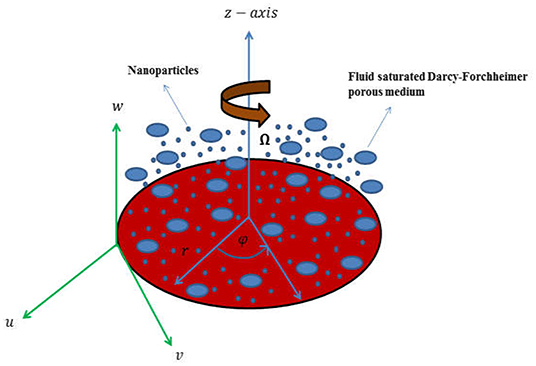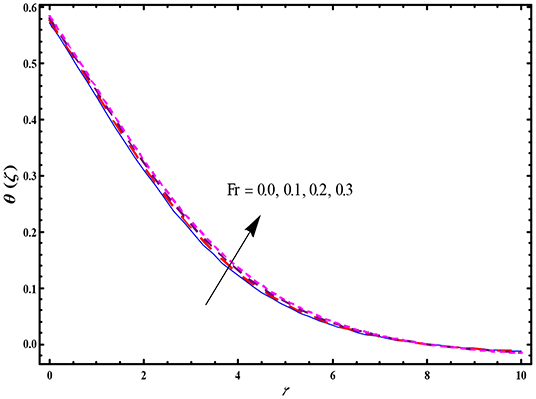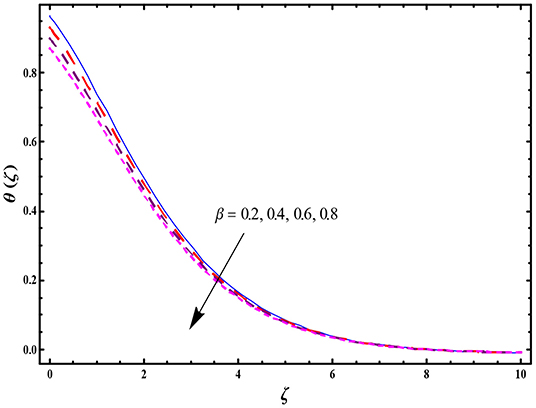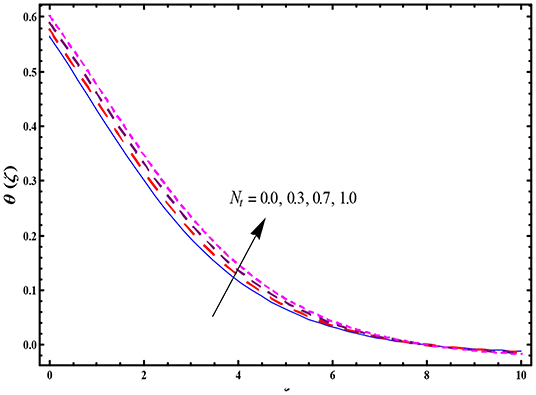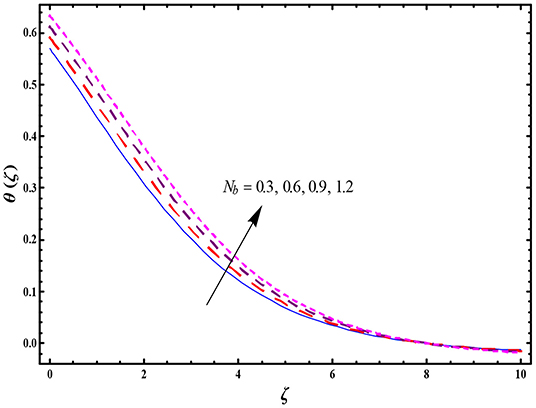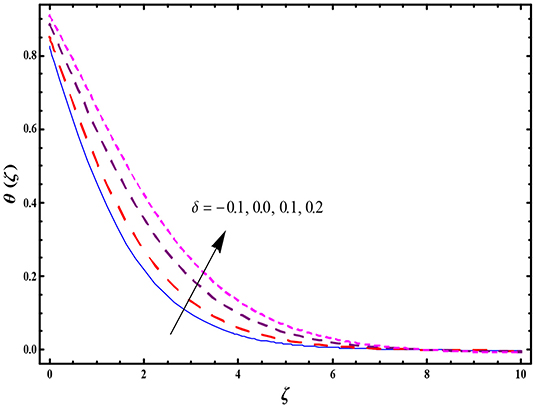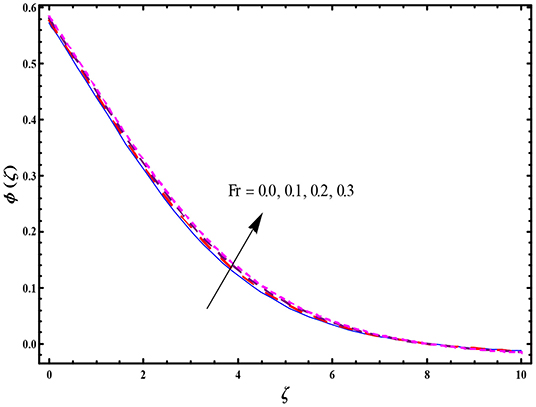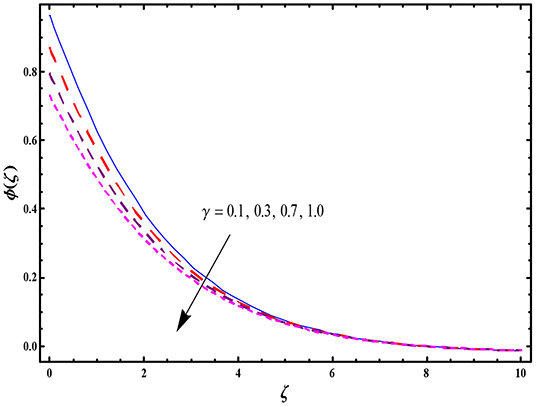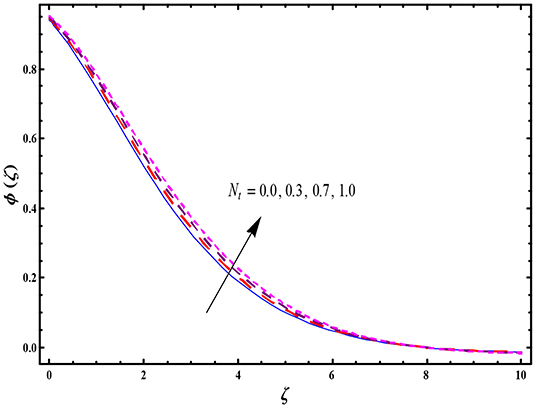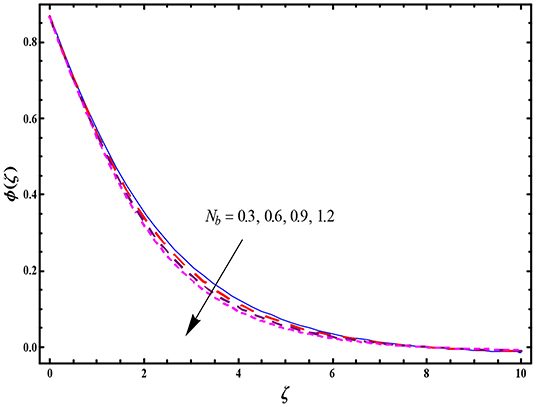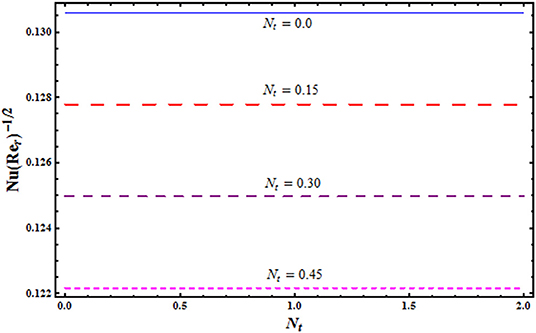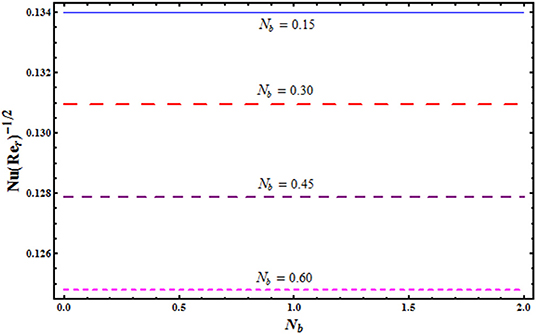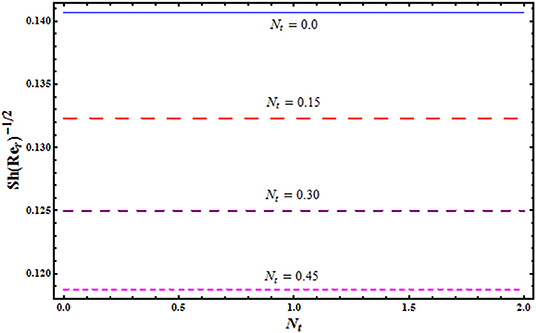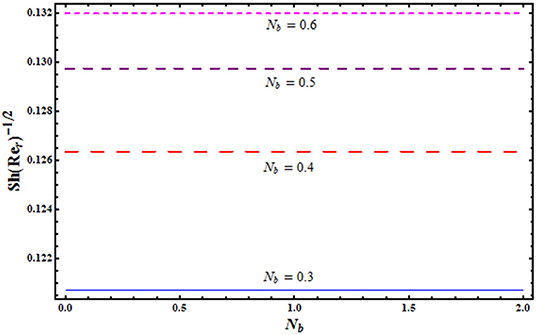- 1Department of Mathematics, Faculty of Science, King Abdulaziz University, Jeddah, Saudi Arabia
- 2Department of Science and High Technology, University of Insubria, Como, Italy
- 3Department of Information Technology, Uppsala University, Uppsala, Sweden
- 4Department of Mathematics, Cankaya University, Ankara, Turkey
- 5Institute of Space Sciences, Bucharest, Romania
This study examines Darcy-Forchheimer 3D nanoliquid flow caused by a rotating disk with heat generation/absorption. The impacts of Brownian motion and thermophoretic are considered. Velocity, concentration, and thermal slips at the surface of the rotating disk are considered. The change from the non-linear partial differential framework to the non-linear ordinary differential framework is accomplished by utilizing appropriate variables. A shooting technique is utilized to develop a numerical solution of the resulting framework. Graphs have been sketched to examine how the concentration and temperature fields are affected by several pertinent flow parameters. Skin friction and local Sherwood and Nusselt numbers are additionally plotted and analyzed. Furthermore, the concentration and temperature fields are enhanced for larger values of the thermophoresis parameter.
1. Introduction
Flow due to a rotating disk plays an indispensable role in numerous modern items encompassing rotating machinery, apparatuses, rotors, and flywheels. As of late, rotating disks have become a significant component of many pieces of machinery, for example, thermal power-creation frameworks, rotor-stator turning circle reactors, electrical controls, stopping mechanisms, pivoting sawing machines, and rotational air cleaning systems. Close investigations of laminar boundary layer flow were carried out by Von Karman [1]. Turkyilmazoglu and Senel [2] examined the linked features of heat and mass exchange arising from the revolution of a hard and permeable disk. Entropy generation in slip flow by the turning of a permeable disk with MHD and variable properties was clarified by Rashidi et al. [3]. Nanofluid flow because of the revolution of a disk was explored by Turkyilmazoglu [4]. Hatami et al. [5] investigated the impacts of the contraction, turning, and heat of disks on the movement of nanofluids. They utilized a least-square strategy for solution development. Mustafa et al. [6] deciphered the three-dimensional rotating flow of nanofluids over a stationary disk. Sheikholeslami et al. [7] created numerical models of nanofluid splashing on a slanted turning disk. Transient thermophoretic molecule deposition through the constrained convective flow of micropolar liquid over a pivoting disk was examined by Doh and Muthtamilselvan [8]. Hayat et al. [9] discussed Darcy-Forchheimer flow of carbon nanotubes in response to a turning disk. Aziz et al. [10] gave a numerical report on nanofluid flow from the pivoting of a disk, looking at the impacts of slip and heat absorption/generation. Synthetically responsive flow of third-grade nanofluid over a stretchable turning disk with heat generation was broken down by Hayat et al. [11]. The radiative flow of a suspension of nanoparticles and gyrotactic microorganisms by the variably thick surface of a turning disk was clarified by Qayyum et al. [12]. Hayat et al. [13] presented a numerical simulation of the radiative flow of carbon nanotubes due to the revolution of a disk with partial slip.
The low thermal productivity of working fluids is a guideline problem for several heat transport components in engineering applications. For this reason, some researchers are making efforts to develop an innovative course for the improvement of the thermal efficiency of working fluids. Various measures have been proposed by experts to improve the thermal efficiency of fluids. Accordingly, the incorporation of nanomaterial into the working fluid, making what is termed a nanofluid, is extremely promising. Recent assessments of nanofluids reveal that working fluid has totally different features with the addition of nanomaterial. This is because the thermal efficiency of the working liquid is lower than that of the nanomaterial. Nanofluid is suspension of fluids containing standard fluid with the particles of nano-measure. Such nanomaterials are utilized in materials, MHD control generators, oil stores, cooling of nuclear reactors, vehicle transformers, and various others [14–18]. Choi and Eastman [19] coined the term nanofluid. They proposed that nanomaterials are a groundbreaking contender for the development of heat transport via the customary fluids. Buongiorno proposed a numerical model of convective transport by nanofluid [20]. Here, thermophoresis and Brownian motion are viewed as the most important slip mechanisms. Heat transfer increase by nanofluids in a two-sided top-driven heated square hole was considered by Tiwari and Das [21]. The significance of a CuO-water nanomaterial on the outside of heat exchangers was tentatively examined by Pantzali et al. [22]. Few ongoing studies on nanofluid flow can be found in the literature [23–45].
Motivated by the above-mentioned articles, the objective here is to examine the impacts of heat absorption/generation in Darcy-Forchheimer 3D nanofluid flow caused by a rotating disk and the impacts of slip. Both Brownian diffusion and thermophoretic phenomena occur in view of the existence of nanoparticles. Velocity, concentration, and thermal slips are accounted for. The obtained framework is solved numerically by the shooting technique. Concentration, temperature, skin friction, and local Sherwood and Nusselt numbers are also analyzed through plots.
2. Mathematical Modeling
Let us examine steady Darcy-Forchheimer 3D nanoliquid flow caused by a rotating disk with slip and heat absorption/generation. A disk at z = 0 rotates with constant angular velocity Ω (see Figure 1). The impacts of Brownian motion and thermophoretis are accounted for. The velocities are (u, v, w) in the directions of increase in (r, φ, z), respectively. The resulting boundary layer expressions are [45, 46]:
It is subject to the boundary conditions [10]:
Here u, v, and w represent the velocity components in the directions r, φ, and z while ρf, μ and, ν(= μ/ρf) depict the fluid density, dynamic, and kinematic viscosities respectively, Cb the drag factor, L1 the velocity slip factor, L2 the thermal slip factor (ρc)p, the effective heat capacity of nanoparticles, T the fluid temperature, k* the permeability of porous space, C the concentration (ρc)f, the heat capacity of the liquid, L3 the concentration slip factor, C∞ the ambient concentration, DT the thermophoretic factor, the non-uniform inertia factor, k and the thermal conductivity and thermal diffusivity, respectively, DB the Brownian factor, Q the heat generation/absorption factor and T∞ the ambient temperature. Selecting [10]:
Continuity Equation (1) is trivially verified, while Equations (2)−(8) yield
Here, Fr stands for the Forchheimer number, α for the velocity slip parameter, λ for the porosity parameter, Nt for the thermophoresis parameter, β for the thermal slip parameter, Pr for the Prandtl number, Nb for Brownian motion, δ for the heat absorption/generation parameter, γ for the concentration slip parameter, and Sc for the Schmidt number. Non-dimensional variables are defined by
The coefficients of skin friction and the Nusselt and Sherwood numbers are
where Rer = 2(Ωr)r/ν represents the local rotational Reynolds number.
3. Numerical Results and Discussion
This section depicts the contributions of various physical variables like thermophoresis parameter Nt, Forchheimer number Fr, thermal slip parameter β, heat generation/absorption parameter δ, Brownian number Nb, and concentration slip number γ on The concentration ϕ(ζ) and temperature θ(ζ) distributions. The effect of Forchheimer variable Fr on θ(ζ) is portrayed in Figure 2. A larger value for Fr shows expanding behavior of θ(ζ) and the related thermal layer. Figure 3 shows the impact of thermal slip β on temperature θ(ζ). Temperature is reduced by increasing thermal slip β. Figure 4 demonstrates the effect of Nt on the temperature field θ(ζ). A larger thermophoresis parameter Nt value leads to a higher temperature field and thicker dynamically warm layer. The reason for this conflict is that growth in Nt yields high grounded thermophoresis control, which further allows movement of the nanoparticles in the fluid zone. A long way from the surface, a more grounded temperature scattering θ(ζ) and continuously warm layer is thus created. The impact of Nb on the temperature profile θ(ζ) is portrayed in Figure 5. Physically, the irregularity of nanoparticle movement increases by enhancing Brownian motion, due to which collision of particles occurs. Thus, kinetic energy is converted into heat energy, which produces an increase in the temperature field. Figure 6 shows how heat generation/absorption δ influences temperature dispersion θ(ζ). Here, δ > 0 portrays heat generation and δ < 0 for heat absorption. Both temperature θ(ζ) and the warm layer are upgraded with increasing δ. Figure 7 shows that concentration ϕ(ζ) is higher for larger values of the Forchheimer variable Fr. Figure 8 shows how concentration ϕ(ζ) is influenced by concentration slip γ. Concentration is reduced at higher estimations of γ. Figure 9 demonstrates how the thermophoresis parameter Nt influences the concentration ϕ(ζ). By improving thermophoresis parameter Nt, the concentration ϕ(ζ) is increased. Figure 10 depicts the impact of Brownian motion Nb on concentration ϕ(ζ). It has been noted that a stronger concentration ϕ(ζ) is developed by utilizing greater Nb. Figures S1, S2 display the impacts of Fr on and , respectively. It is noted that is a decaying function of Fr, while the reverse situation is observed for . The effects of Nt and Nb on are highlighted in Figures 11, 12, respectively. Here, reduces for Nt and Nb. The effects of Nt and Nb on are portrayed in Figures 13, 14, respectively. Here, is an increasing factor of Nt, while the opposite trend is seen for Nb. The figures in Table 1 were computed to validate the present results with previously published results in a limiting sense. Here, we see that the present numerical solution is in good agreement with the previous solution by Naqvi et al. [45] in a limiting sense.
4. Conclusions
In this paper, Darcy-Forchheimer 3D nanofluid flow caused by a rotating disk with heat generation/absorption is studied. Brownian motion and thermophoretic phenomena occur with the existence of nanoparticles. Velocity, concentration, and thermal slips are accounted for. A higher Forchheimer number Fr depicts similar behavior for concentration and temperature. A larger β corresponds to a lower temperature field. Higher γ depicts decreasing behavior for the concentration field. A stronger temperature field is observed for Nb and Nt. Concentration ϕ(ζ) displays the reverse behavior for Nb and Nt.
Data Availability Statement
The datasets generated for this study are available on request to the corresponding author.
Author Contributions
All authors listed have made a substantial, direct and intellectual contribution to the work, and approved it for publication.
Conflict of Interest
The authors declare that the research was conducted in the absence of any commercial or financial relationships that could be construed as a potential conflict of interest.
Acknowledgments
This project was funded by the Deanship of Scientific Research (DSR), King Abdulaziz University, Jeddah, Saudi Arabia under grant no. KEP-16-130-40. The authors, therefore, acknowledge with thanks DSR technical and financial support.
Supplementary Material
The Supplementary Material for this article can be found online at: https://www.frontiersin.org/articles/10.3389/fphy.2019.00219/full#supplementary-material
Figure S1. Variations of for Fr.
Figure S2. Variations of for Fr.
References
1. Von Karman T. Uber laminare and turbulente Reibung. Z Angew Math Mech. (1921) 1:233–52. doi: 10.1002/zamm.19210010401
2. Turkyilmazoglu M, Senel P. Heat and mass transfer of the flow due to a rotating rough and porous disk. Int J Therm Sci. (2013) 63:146–58. doi: 10.1016/j.ijthermalsci.2012.07.013
3. Rashidi MM, Kavyani N, Abelman S. Investigation of entropy generation in MHD and slip flow over rotating porous disk with variable properties. Int J Heat Mass Transf. (2014) 70:892–917. doi: 10.1016/j.ijheatmasstransfer.2013.11.058
4. Turkyilmazoglu M. Nanofluid flow and heat transfer due to a rotating disk. Comput Fluids. (2014) 94:139–46. doi: 10.1016/j.compfluid.2014.02.009
5. Hatami M, Sheikholeslami M, Gangi DD. Laminar flow and heat transfer of nanofluids between contracting and rotating disks by least square method. Powder Technol. (2014) 253:769–79. doi: 10.1016/j.powtec.2013.12.053
6. Mustafa M, Khan JA, Hayat T, Alsaedi A. On Bödewadt flow and heat transfer of nanofluids over a stretching stationary disk. J Mol Liquid. (2015) 211:119–25. doi: 10.1016/j.molliq.2015.06.065
7. Sheikholeslami M, Hatami M, Ganji DD. Numerical investigation of nanofluid spraying on an inclined rotating disk for cooling process. J Mol Liquid. (2015) 211:577–83. doi: 10.1016/j.molliq.2015.07.006
8. Doh DH, Muthtamilselvan M. Thermophoretic particle deposition on magnetohydrodynamic flow of micropolar fluid due to a rotating disk. Int J Mech Sci. (2017) 130:350–9. doi: 10.1016/j.ijmecsci.2017.06.029
9. Hayat T, Haider F, Muhammad T, Alsaedi A. On Darcy-Forchheimer flow of carbon nanotubes due to a rotating disk. Int J Heat Mass Transf. (2017) 112:248–54. doi: 10.1016/j.ijheatmasstransfer.2017.04.123
10. Aziz A, Alsaedi A, Muhammad T, Hayat T. Numerical study for heat generation/absorption in flow of nanofluid by a rotating disk. Results Phys. (2018) 8:785–92. doi: 10.1016/j.rinp.2018.01.009
11. Hayat T, Ahmad S, Khan MI, Alsaedi A. Modeling and analyzing flow of third grade nanofluid due to rotating stretchable disk with chemical reaction and heat source. Phys B. (2018) 537:116–26. doi: 10.1016/j.physb.2018.01.052
12. Qayyum S, Imtiaz M, Alsaedi A, Hayat T. Analysis of radiation in a suspension of nanoparticles and gyrotactic microorganism for rotating disk of variable thickness. Chin J Phys. (2018) 56:2404–23. doi: 10.1016/j.cjph.2018.06.020
13. Hayat T, Khalid H, Waqas M, Alsaedi A. Numerical simulation for radiative flow of nanoliquid by rotating disk with carbon nanotubes and partial slip. Comput Methods Appl Mech Eng. (2018) 341:397–408. doi: 10.1016/j.cma.2018.06.018
14. Mabood F, Ibrahim SM, Lorenzini G. Chemical reaction effects on MHD rotating fluid over a vertical plate embedded in porous medium with heat source. J Eng Thermophys. (2017) 26:399–415. doi: 10.1134/S1810232817030109
15. Mabood F, Lorenzini G, Pochai N, Shateyi S. Homotopy analysis method for radiation and hydrodynamic-thermal slips effects on MHD flow and heat transfer impinging on stretching sheet. Defect Diffusion Forum. (2018) 388:317–27. doi: 10.4028/www.scientific.net/DDF.388.317
16. Mabood F, Das K. Outlining the impact of melting on MHD Casson fluid flow past a stretching sheet in a porous medium with radiation. Heliyon. (2019) 5:e01216. doi: 10.1016/j.heliyon.2019.e01216
17. Mabood F, Nayak MK, Chamkha AJ. Heat transfer on the cross flow of micropolar fluids over a thin needle moving in a parallel stream influenced by binary chemical reaction and Arrhenius activation energy. Eur Phys J Plus. (2019) 134:427. doi: 10.1140/epjp/i2019-12716-9
18. Imtiaz M, Mabood F, Hayat T, Alsaedi A. Homogeneous-heterogeneous reactions in MHD radiative flow of second grade fluid due to a curved stretching surface. Int J Heat Mass Transf. (2019) 145:118781. doi: 10.1016/j.ijheatmasstransfer.2019.118781
19. Choi SUS, Eastman JA. Enhancing thermal conductivity of fluids with nanoparticles. ASME Int Mech Eng Cong Exp. (1995) 66:99–105.
20. Buongiorno J. Convective transport in nanofluids. ASME J Heat Transf. (2006) 128:240–50. doi: 10.1115/1.2150834
21. Tiwari RK, Das MK. Heat transfer augmentation in a two-sided lid-driven differentially heated square cavity utilizing nanofluid. Int J Heat Mass Transf. (2007) 50:2002–18. doi: 10.1016/j.ijheatmasstransfer.2006.09.034
22. Pantzali MN, Mouza AA, Paras SV. Investigating the efficacy of nanofluids as coolants in plate heat exchangers (PHE). Chem Eng Sci. (2009) 64:3290–300. doi: 10.1016/j.ces.2009.04.004
23. Sheikholeslami M, Bandpy MG, Ganji DD, Soleimani S. Effect of a magnetic field on natural convection in an inclined half-anulus enclosure filled with Cu-water nanofluid using CVFEM. Adv Powder Technol. (2013) 24:980–91. doi: 10.1016/j.apt.2013.01.012
24. Togun H, Safaei MR, Sadri R, Kazi SN, Badarudin A, Hooman K, et al. Numerical simulation of laminar to turbulent nanofluid flow and heat transfer over a backward-facing step. Appl Math Comput. (2014) 239:153–70. doi: 10.1016/j.amc.2014.04.051
25. Hayat T, Aziz A, Muhammad T, Ahmad B. Influence of magnetic field in three-dimensional flow of couple stress nanofluid over a nonlinearly stretching surface with convective condition. PLoS ONE. (2015) 10:e0145332. doi: 10.1371/journal.pone.0145332
26. Lin Y, Zheng L, Zhang X, Ma L, Chen G. MHD pseudo-plastic nanofluid unsteady flow and heat transfer in a finite thin film over stretching surface with internal heat generation. Int J Heat Mass Transf. (2015) 84:903–11. doi: 10.1016/j.ijheatmasstransfer.2015.01.099
27. Hayat T, Muhammad T, Alsaedi A, Alhuthali MS. Magnetohydrodynamic three-dimensional flow of viscoelastic nanofluid in the presence of nonlinear thermal radiation. J Magn Mater. (2015) 385: 222–9. doi: 10.1016/j.jmmm.2015.02.046
28. Gireesha BJ, Mahanthesh B, Shivakumara IS, Eshwarappa KM. Melting heat transfer in boundary layer stagnation-point flow of nanofluid toward a stretching sheet with induced magnetic field. Int J Eng Sci Technol. (2016) 19:313–21. doi: 10.1016/j.jestch.2015.07.012
29. Hayat T, Aziz A, Muhammad T, Alsaedi A. On magnetohydrodynamic three-dimensional flow of nanofluid over a convectively heated nonlinear stretching surface. Int J Heat Mass Transf. (2016) 100:566–72. doi: 10.1016/j.ijheatmasstransfer.2016.04.113
30. Goshayeshi HR, Safaei MR, Goodarzi M, Dahari M. Particle size and type effects on heat transfer enhancement of Ferro-nanofluids in a pulsating heat pipe. Powder Technol. (2016) 301:1218–26. doi: 10.1016/j.powtec.2016.08.007
31. Eid MR, Alsaedi A, Muhammad T, Hayat T. Comprehensive analysis of heat transfer of gold-blood nanofluid (Sisko-model) with thermal radiation. Results Phys. (2017) 7:4388–93. doi: 10.1016/j.rinp.2017.11.004
32. Hayat T, Muhammad T, Shehzad SA, Alsaedi A. An analytical solution for magnetohydrodynamic Oldroyd-B nanofluid flow induced by a stretching sheet with heat generation/absorption. Int J Therm Sci. (2017) 111:274–88. doi: 10.1016/j.ijthermalsci.2016.08.009
33. Hayat T, Sajjad R, Muhammad T, Alsaedi A, Ellahi R. On MHD nonlinear stretching flow of Powell-Eyring nanomaterial. Results Phys. (2017) 7:535–43. doi: 10.1016/j.rinp.2016.12.039
34. Bhatti MM, Zeeshan A, Ellahi R. Simultaneous effects of coagulation and variable magnetic field on peristaltically induced motion of Jeffrey nanofluid containing gyrotactic microorganism. Microvasc Res. (2017) 110:32–42. doi: 10.1016/j.mvr.2016.11.007
35. Muhammad T, Alsaedi A, Shehzad SA, Hayat T. A revised model for Darcy-Forchheimer flow of Maxwell nanofluid subject to convective boundary condition. Chinese J Phys. (2017) 55:963–76. doi: 10.1016/j.cjph.2017.03.006
36. Muhammad T, Alsaedi A, Hayat T, Shehzad SA. A revised model for Darcy-Forchheimer three-dimensional flow of nanofluid subject to convective boundary condition. Results Phys. (2017) 7:2791–7. doi: 10.1016/j.rinp.2017.07.052
37. Muhammad T, Lu DC, Mahanthesh B, Eid MR, Ramzan M, Dar A. Significance of Darcy-Forchheimer porous medium in nanofluid through carbon nanotubes. Commun Theor Phys. (2018) 70:361. doi: 10.1088/0253-6102/70/3/361
38. Hayat T, Hussain Z, Alsaedi A, Muhammad T. An optimal solution for magnetohydrodynamic nanofluid flow over a stretching surface with constant heat flux and zero nanoparticles flux. Neural Comp. Appl. (2018) 29:1555–62. doi: 10.1007/s00521-016-2685-x
39. Shehzad N, Zeeshan A, Ellahi R, Rashidi S. Modelling study on internal energy loss due to entropy generation for non-Darcy Poiseuille flow of silver-water nanofluid: an application of purification. Entropy. (2018) 20:851. doi: 10.3390/e20110851
40. Ellahi R, Zeeshan A, Shehzad N, Alamri SZ. Structural impact of kerosene-Al2O3 nanoliquid on MHD Poiseuille flow with variable thermal conductivity: application of cooling process. J Mol Liquid. (2018) 264:607–15. doi: 10.1016/j.molliq.2018.05.103
41. Shehzad N, Zeeshan A, Ellahi R. Electroosmotic flow of MHD Power law Al2O3-PVC nanofluid in a horizontal channel: Couette-Poiseuille flow model. Commun Theor Phys. (2018) 69:655–66. doi: 10.1088/0253-6102/69/6/655
42. Zeeshan A, Shehzad N, Abbas T, Ellahi R. Effects of radiative electro-magnetohydrodynamics diminishing internal energy of pressure-driven flow of titanium dioxide-water nanofluid due to entropy generation. Entropy. (2019) 21:236. doi: 10.3390/e21030236
43. Mabood F, Ibrahim SM, Khan WA. Effect of melting and heat generation/absorption on Sisko nanofluid over a stretching surface with nonlinear radiation. Phys Scripta. (2019) 94:065701. doi: 10.1088/1402-4896/ab1164
44. Zeeshan A, Ellahi R, Mabood F, Hussain F. Numerical study on bi-phase coupled stress fluid in the presence of Hafnium and metallic nanoparticles over an inclined plane. Int J Numer Methods Heat Fluid Flow. (2019) 29:2854–69. doi: 10.1108/HFF-11-2018-0677
45. Naqvi SMRS, Muhammad T, Kim HM, Mahmood T, Saeed A, Khan BS. Numerical treatment for Darcy-Forchheimer flow of nanofluid due to a rotating disk with slip effects. Can J Phys. (2019) 97:856–63. doi: 10.1139/cjp-2018-0553
Keywords: rotating disk, Darcy-Forchheimer flow, nanoparticles, heat absorption/generation, slip conditions, numerical solution
Citation: Ullah MZ, Serra-Capizzano S and Baleanu D (2020) A Numerical Simulation for Darcy-Forchheimer Flow of Nanofluid by a Rotating Disk With Partial Slip Effects. Front. Phys. 7:219. doi: 10.3389/fphy.2019.00219
Received: 01 November 2019; Accepted: 28 November 2019;
Published: 15 January 2020.
Edited by:
Ahmed Zeeshan, International Islamic University, Islamabad, PakistanReviewed by:
Nasir Shehzad, Govt. College Khayaban-E-Sir Syed, PakistanMustafa Turkyilmazoglu, Hacettepe University, Turkey
Copyright © 2020 Ullah, Serra-Capizzano and Baleanu. This is an open-access article distributed under the terms of the Creative Commons Attribution License (CC BY). The use, distribution or reproduction in other forums is permitted, provided the original author(s) and the copyright owner(s) are credited and that the original publication in this journal is cited, in accordance with accepted academic practice. No use, distribution or reproduction is permitted which does not comply with these terms.
*Correspondence: Malik Zaka Ullah, em1hbGVrQGthdS5lZHUuc2E=
 Malik Zaka Ullah
Malik Zaka Ullah Stefano Serra-Capizzano2,3
Stefano Serra-Capizzano2,3 Dumitru Baleanu
Dumitru Baleanu